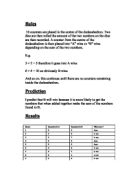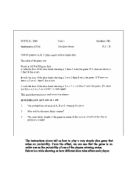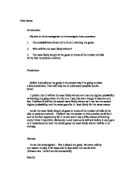“A Wins” “B Wins”
Win = 1 Win = 6
Draw = 3 Draw = 3
Lose = 6 Lose = 1
We can write this as a probability equation:
P(A Wins) = 1/10
P(B Wins) = 6/10
P(Draw) = 3/10
And
P(A Wins) = 41/100
P(B Wins) = 59/100
Conclusion:
From the results I have produced it becomes evident that my prediction was correct. However, I will have to play the game a many number of times to obtain clearer and more accurate results.
P(A Wins) = 12/36 = 1/3
P(A Wins) = 24/36 = 2/3
The possibilities found above are from using my possibility diagram.
All of the green coloured squares have a higher probability of being obtained, as shown in the diagram above. Therefore the game is unfair. For example, there are 5 different ways of getting 8 whereas there are only 2 ways of reaching 11.
The probability of A winning is 1/3 and B winning 2/3. Showing that the game is foul not fair. Extension Work
The probability of A winning is 1/3, but this only applies to one counter. I am now going to find out the probability of A winning a game instead of winning a counter.
For A to win the game, A needs to win at least 6 or more counters.
For A to win the game A needs to win:
1 way of winning all ten counters
10 ways of winning all 9 counters
To be able to solve this investigation I will need to simplify it. At the minute it is too long.
I decided that by doing the investigation in stages it would be a lot easier. So I decided to do a 2 counter game:
A A 1 way of getting 2 A’s
A B 2 ways of getting 1 A
B A “ “ “ “ “ “ “ “
B B 1 way of getting 0 A’s
4 combinations
3 counter game
A A A 1 way of getting 3 A’s
A A B }
A B A } 3 ways of getting 2 A’s
B A A }
A B B }
B A B } 3 ways of getting 1 A
B B A }
B B B 1 way of getting o A’s
4 counter game
A A A B }
A A B A } 4 ways of getting
A B A A } 3 A’s
B A A A }
A B A B }
A A B B }
A B B A } 6 ways of getting
B B A A } 2 A’s
B A A B }
B A B A }
A B B B }
B B B A } 4 ways of getting
B B A B } 1 A
B A B B }
B B B B 1 way of getting no A’s
I am going to rewrite my findings from a vertical representation to a horizontal representation, to see if there is a pattern developing.
Pascal’s triangle
I have formed this triangle by arranging the results from the first 5 rows which have been taken from the various A and B. From this I could see a pattern developing. The pattern that I developed was the two numbers diagonally above the number were added together to get the bottom number.
E.G.
This triangle is called Pascal’s triangle.
Overall conclusion
From my findings it becomes evident to me that both the probability of B winning one counter and the game is considerably more likely than it is for A to win a counter and the match. The probability of B winning a counter is 2/3 and the likely hood of B winning the game is 0.855. These statistics confirm to me that the game is foul because there is not an equal opportunity of a draw or A or B winning.







